Ngai Tahu Tourism: Change Proposal Report on Agrodome Business
VerifiedAdded on 2022/10/01
|10
|2810
|394
Report
AI Summary
This report provides a comprehensive analysis of change management within the Agrodome business, owned by Ngai Tahu Tourism. It begins with an introduction to change management, defining its systematic approach and importance. The report then provides a company overview of Ngai Tahu Tourism and a detailed look at Agrodome. The core of the report analyzes both internal and external issues impacting the business, including competitive pressures, financial considerations, climate change, and technological advancements. The report explores the relevance of Jack Ma’s philosophy to the Agrodome business. Recommendations are proposed, focusing on climate change initiatives, staff development, and market expansion. The report further details the proposed changes, the challenges faced, and the application of change management theories such as Lewin’s three-step model, Kotter’s 8-step plan, McKinsey 7-S model, and the ADKAR model. A scenario is presented to illustrate the practical application of these theories. The report concludes by summarizing the key findings and emphasizing the importance of continuous improvement and change within the tourism industry, particularly for businesses like Agrodome and Ngai Tahu Tourism.
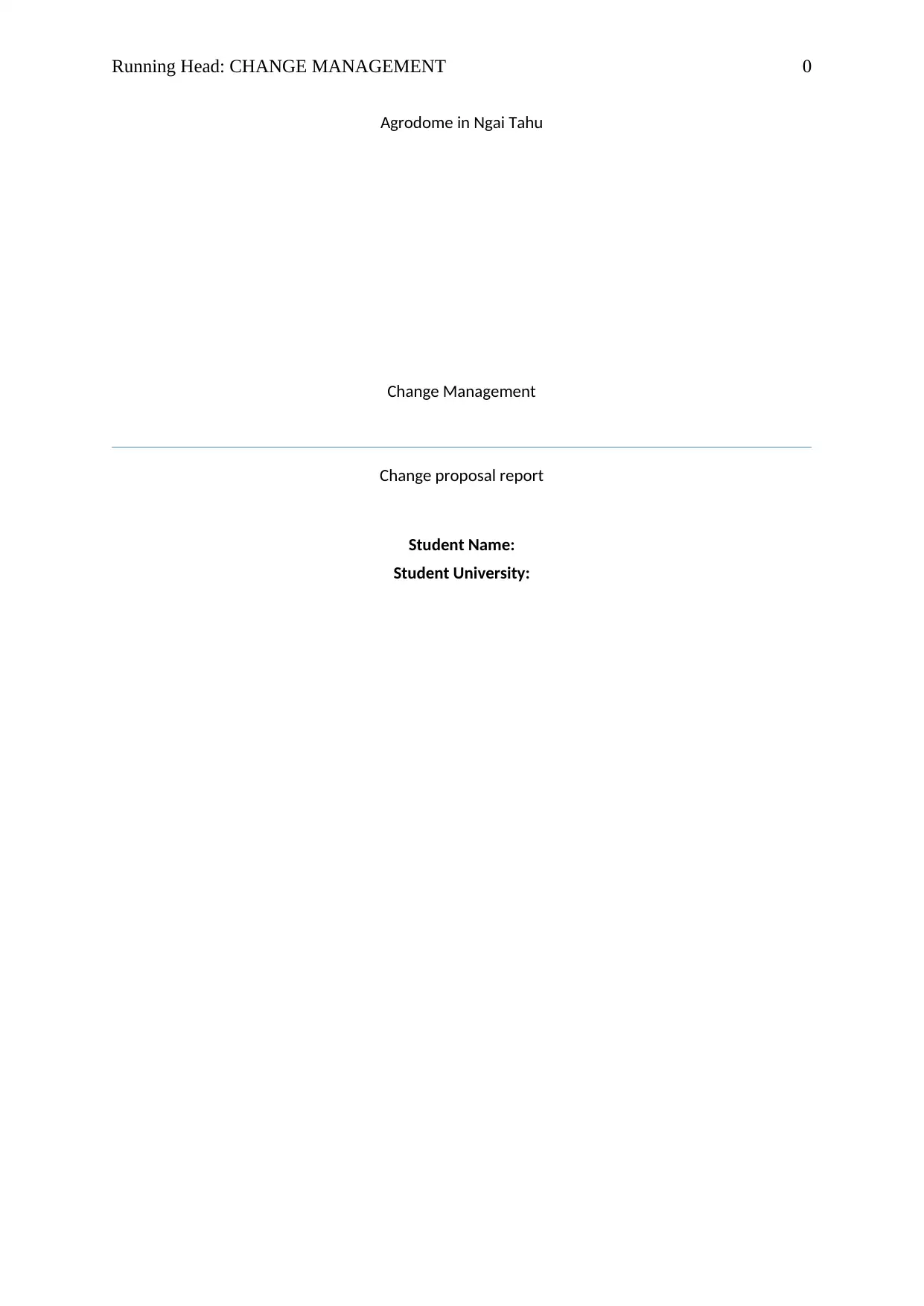
Running Head: CHANGE MANAGEMENT 0
Agrodome in Ngai Tahu
Change Management
Change proposal report
Student Name:
Student University:
Agrodome in Ngai Tahu
Change Management
Change proposal report
Student Name:
Student University:
Paraphrase This Document
Need a fresh take? Get an instant paraphrase of this document with our AI Paraphraser
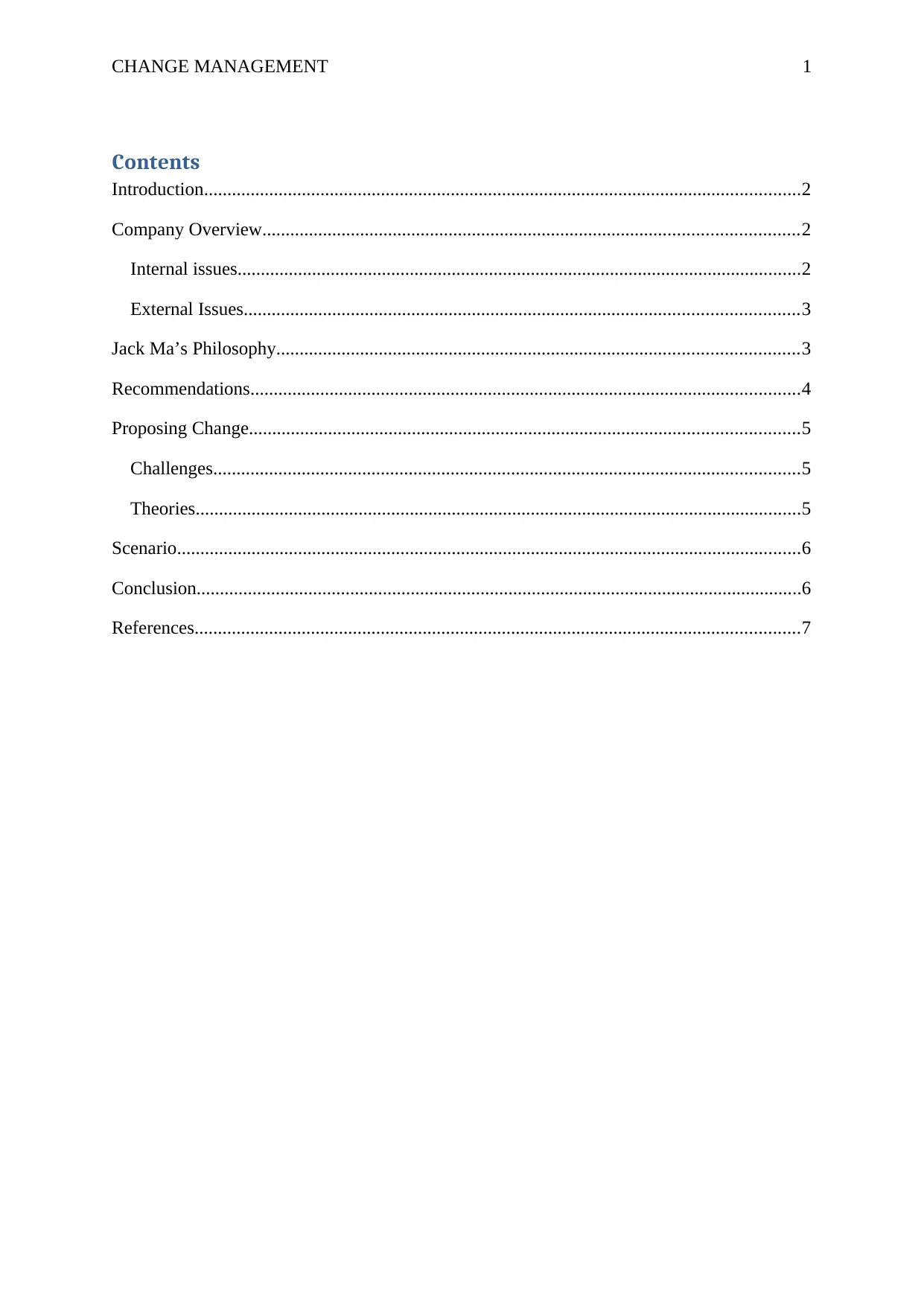
CHANGE MANAGEMENT 1
Contents
Introduction................................................................................................................................2
Company Overview...................................................................................................................2
Internal issues.........................................................................................................................2
External Issues.......................................................................................................................3
Jack Ma’s Philosophy................................................................................................................3
Recommendations......................................................................................................................4
Proposing Change......................................................................................................................5
Challenges..............................................................................................................................5
Theories..................................................................................................................................5
Scenario......................................................................................................................................6
Conclusion..................................................................................................................................6
References..................................................................................................................................7
Contents
Introduction................................................................................................................................2
Company Overview...................................................................................................................2
Internal issues.........................................................................................................................2
External Issues.......................................................................................................................3
Jack Ma’s Philosophy................................................................................................................3
Recommendations......................................................................................................................4
Proposing Change......................................................................................................................5
Challenges..............................................................................................................................5
Theories..................................................................................................................................5
Scenario......................................................................................................................................6
Conclusion..................................................................................................................................6
References..................................................................................................................................7
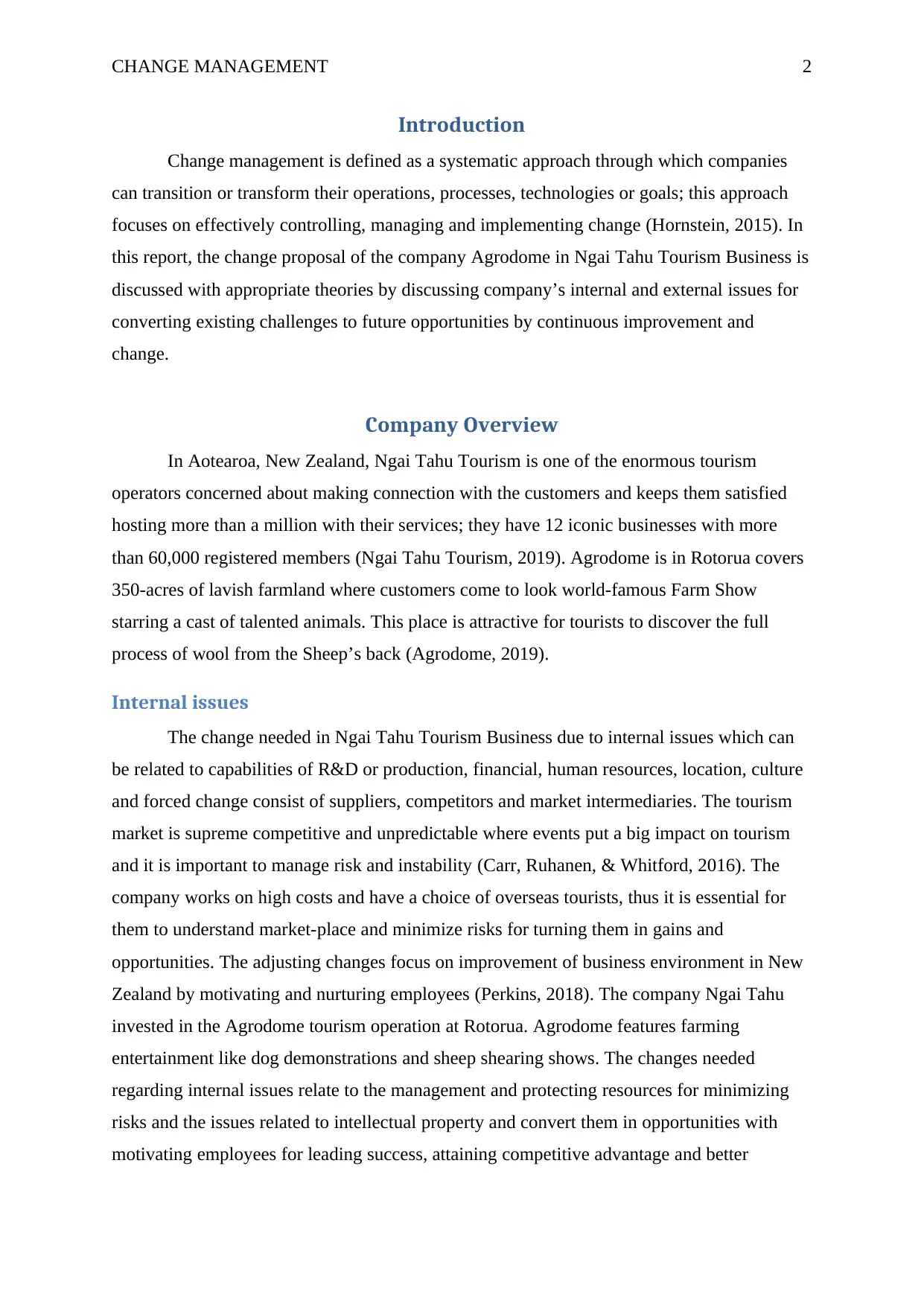
CHANGE MANAGEMENT 2
Introduction
Change management is defined as a systematic approach through which companies
can transition or transform their operations, processes, technologies or goals; this approach
focuses on effectively controlling, managing and implementing change (Hornstein, 2015). In
this report, the change proposal of the company Agrodome in Ngai Tahu Tourism Business is
discussed with appropriate theories by discussing company’s internal and external issues for
converting existing challenges to future opportunities by continuous improvement and
change.
Company Overview
In Aotearoa, New Zealand, Ngai Tahu Tourism is one of the enormous tourism
operators concerned about making connection with the customers and keeps them satisfied
hosting more than a million with their services; they have 12 iconic businesses with more
than 60,000 registered members (Ngai Tahu Tourism, 2019). Agrodome is in Rotorua covers
350-acres of lavish farmland where customers come to look world-famous Farm Show
starring a cast of talented animals. This place is attractive for tourists to discover the full
process of wool from the Sheep’s back (Agrodome, 2019).
Internal issues
The change needed in Ngai Tahu Tourism Business due to internal issues which can
be related to capabilities of R&D or production, financial, human resources, location, culture
and forced change consist of suppliers, competitors and market intermediaries. The tourism
market is supreme competitive and unpredictable where events put a big impact on tourism
and it is important to manage risk and instability (Carr, Ruhanen, & Whitford, 2016). The
company works on high costs and have a choice of overseas tourists, thus it is essential for
them to understand market-place and minimize risks for turning them in gains and
opportunities. The adjusting changes focus on improvement of business environment in New
Zealand by motivating and nurturing employees (Perkins, 2018). The company Ngai Tahu
invested in the Agrodome tourism operation at Rotorua. Agrodome features farming
entertainment like dog demonstrations and sheep shearing shows. The changes needed
regarding internal issues relate to the management and protecting resources for minimizing
risks and the issues related to intellectual property and convert them in opportunities with
motivating employees for leading success, attaining competitive advantage and better
Introduction
Change management is defined as a systematic approach through which companies
can transition or transform their operations, processes, technologies or goals; this approach
focuses on effectively controlling, managing and implementing change (Hornstein, 2015). In
this report, the change proposal of the company Agrodome in Ngai Tahu Tourism Business is
discussed with appropriate theories by discussing company’s internal and external issues for
converting existing challenges to future opportunities by continuous improvement and
change.
Company Overview
In Aotearoa, New Zealand, Ngai Tahu Tourism is one of the enormous tourism
operators concerned about making connection with the customers and keeps them satisfied
hosting more than a million with their services; they have 12 iconic businesses with more
than 60,000 registered members (Ngai Tahu Tourism, 2019). Agrodome is in Rotorua covers
350-acres of lavish farmland where customers come to look world-famous Farm Show
starring a cast of talented animals. This place is attractive for tourists to discover the full
process of wool from the Sheep’s back (Agrodome, 2019).
Internal issues
The change needed in Ngai Tahu Tourism Business due to internal issues which can
be related to capabilities of R&D or production, financial, human resources, location, culture
and forced change consist of suppliers, competitors and market intermediaries. The tourism
market is supreme competitive and unpredictable where events put a big impact on tourism
and it is important to manage risk and instability (Carr, Ruhanen, & Whitford, 2016). The
company works on high costs and have a choice of overseas tourists, thus it is essential for
them to understand market-place and minimize risks for turning them in gains and
opportunities. The adjusting changes focus on improvement of business environment in New
Zealand by motivating and nurturing employees (Perkins, 2018). The company Ngai Tahu
invested in the Agrodome tourism operation at Rotorua. Agrodome features farming
entertainment like dog demonstrations and sheep shearing shows. The changes needed
regarding internal issues relate to the management and protecting resources for minimizing
risks and the issues related to intellectual property and convert them in opportunities with
motivating employees for leading success, attaining competitive advantage and better
⊘ This is a preview!⊘
Do you want full access?
Subscribe today to unlock all pages.

Trusted by 1+ million students worldwide
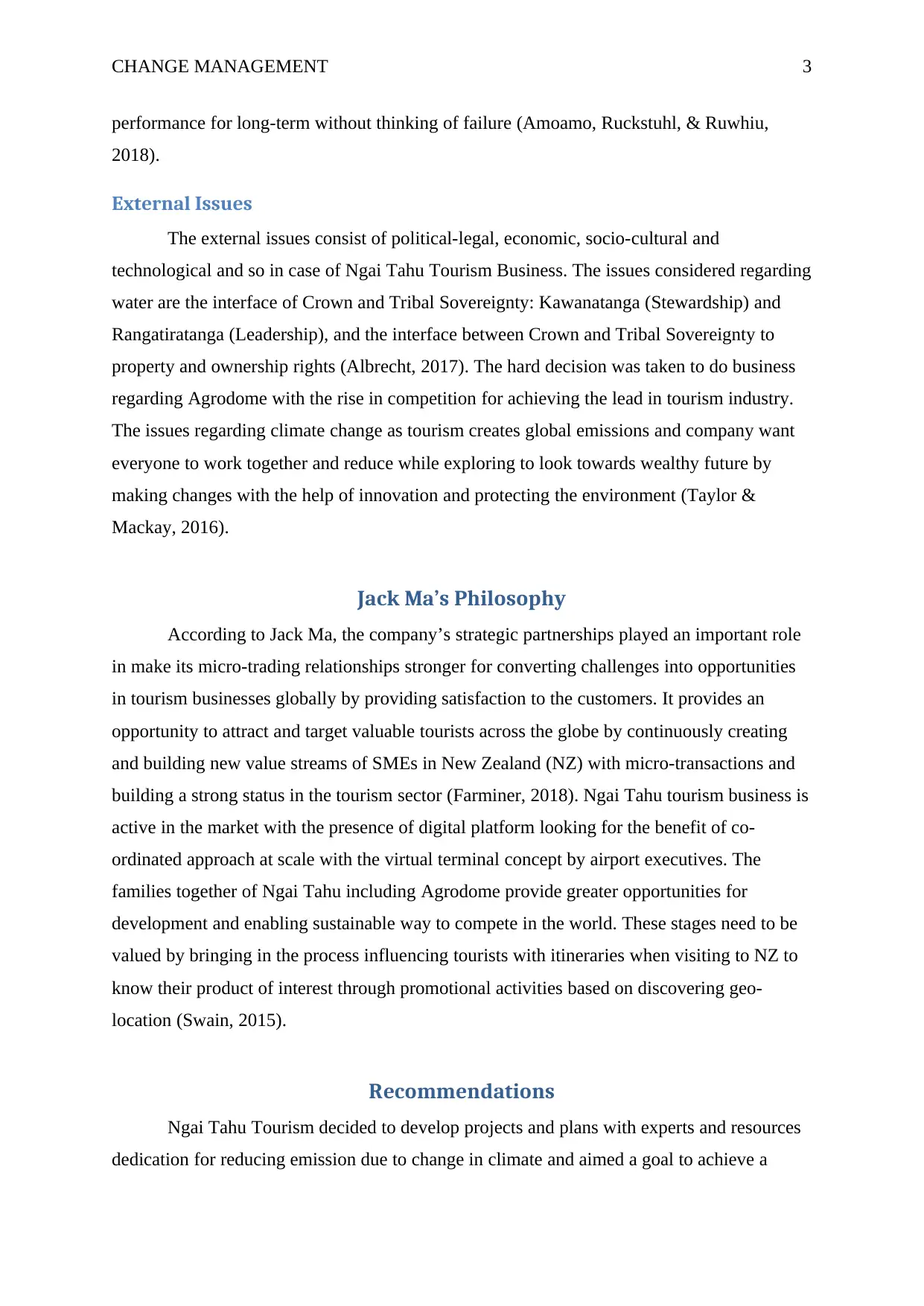
CHANGE MANAGEMENT 3
performance for long-term without thinking of failure (Amoamo, Ruckstuhl, & Ruwhiu,
2018).
External Issues
The external issues consist of political-legal, economic, socio-cultural and
technological and so in case of Ngai Tahu Tourism Business. The issues considered regarding
water are the interface of Crown and Tribal Sovereignty: Kawanatanga (Stewardship) and
Rangatiratanga (Leadership), and the interface between Crown and Tribal Sovereignty to
property and ownership rights (Albrecht, 2017). The hard decision was taken to do business
regarding Agrodome with the rise in competition for achieving the lead in tourism industry.
The issues regarding climate change as tourism creates global emissions and company want
everyone to work together and reduce while exploring to look towards wealthy future by
making changes with the help of innovation and protecting the environment (Taylor &
Mackay, 2016).
Jack Ma’s Philosophy
According to Jack Ma, the company’s strategic partnerships played an important role
in make its micro-trading relationships stronger for converting challenges into opportunities
in tourism businesses globally by providing satisfaction to the customers. It provides an
opportunity to attract and target valuable tourists across the globe by continuously creating
and building new value streams of SMEs in New Zealand (NZ) with micro-transactions and
building a strong status in the tourism sector (Farminer, 2018). Ngai Tahu tourism business is
active in the market with the presence of digital platform looking for the benefit of co-
ordinated approach at scale with the virtual terminal concept by airport executives. The
families together of Ngai Tahu including Agrodome provide greater opportunities for
development and enabling sustainable way to compete in the world. These stages need to be
valued by bringing in the process influencing tourists with itineraries when visiting to NZ to
know their product of interest through promotional activities based on discovering geo-
location (Swain, 2015).
Recommendations
Ngai Tahu Tourism decided to develop projects and plans with experts and resources
dedication for reducing emission due to change in climate and aimed a goal to achieve a
performance for long-term without thinking of failure (Amoamo, Ruckstuhl, & Ruwhiu,
2018).
External Issues
The external issues consist of political-legal, economic, socio-cultural and
technological and so in case of Ngai Tahu Tourism Business. The issues considered regarding
water are the interface of Crown and Tribal Sovereignty: Kawanatanga (Stewardship) and
Rangatiratanga (Leadership), and the interface between Crown and Tribal Sovereignty to
property and ownership rights (Albrecht, 2017). The hard decision was taken to do business
regarding Agrodome with the rise in competition for achieving the lead in tourism industry.
The issues regarding climate change as tourism creates global emissions and company want
everyone to work together and reduce while exploring to look towards wealthy future by
making changes with the help of innovation and protecting the environment (Taylor &
Mackay, 2016).
Jack Ma’s Philosophy
According to Jack Ma, the company’s strategic partnerships played an important role
in make its micro-trading relationships stronger for converting challenges into opportunities
in tourism businesses globally by providing satisfaction to the customers. It provides an
opportunity to attract and target valuable tourists across the globe by continuously creating
and building new value streams of SMEs in New Zealand (NZ) with micro-transactions and
building a strong status in the tourism sector (Farminer, 2018). Ngai Tahu tourism business is
active in the market with the presence of digital platform looking for the benefit of co-
ordinated approach at scale with the virtual terminal concept by airport executives. The
families together of Ngai Tahu including Agrodome provide greater opportunities for
development and enabling sustainable way to compete in the world. These stages need to be
valued by bringing in the process influencing tourists with itineraries when visiting to NZ to
know their product of interest through promotional activities based on discovering geo-
location (Swain, 2015).
Recommendations
Ngai Tahu Tourism decided to develop projects and plans with experts and resources
dedication for reducing emission due to change in climate and aimed a goal to achieve a
Paraphrase This Document
Need a fresh take? Get an instant paraphrase of this document with our AI Paraphraser
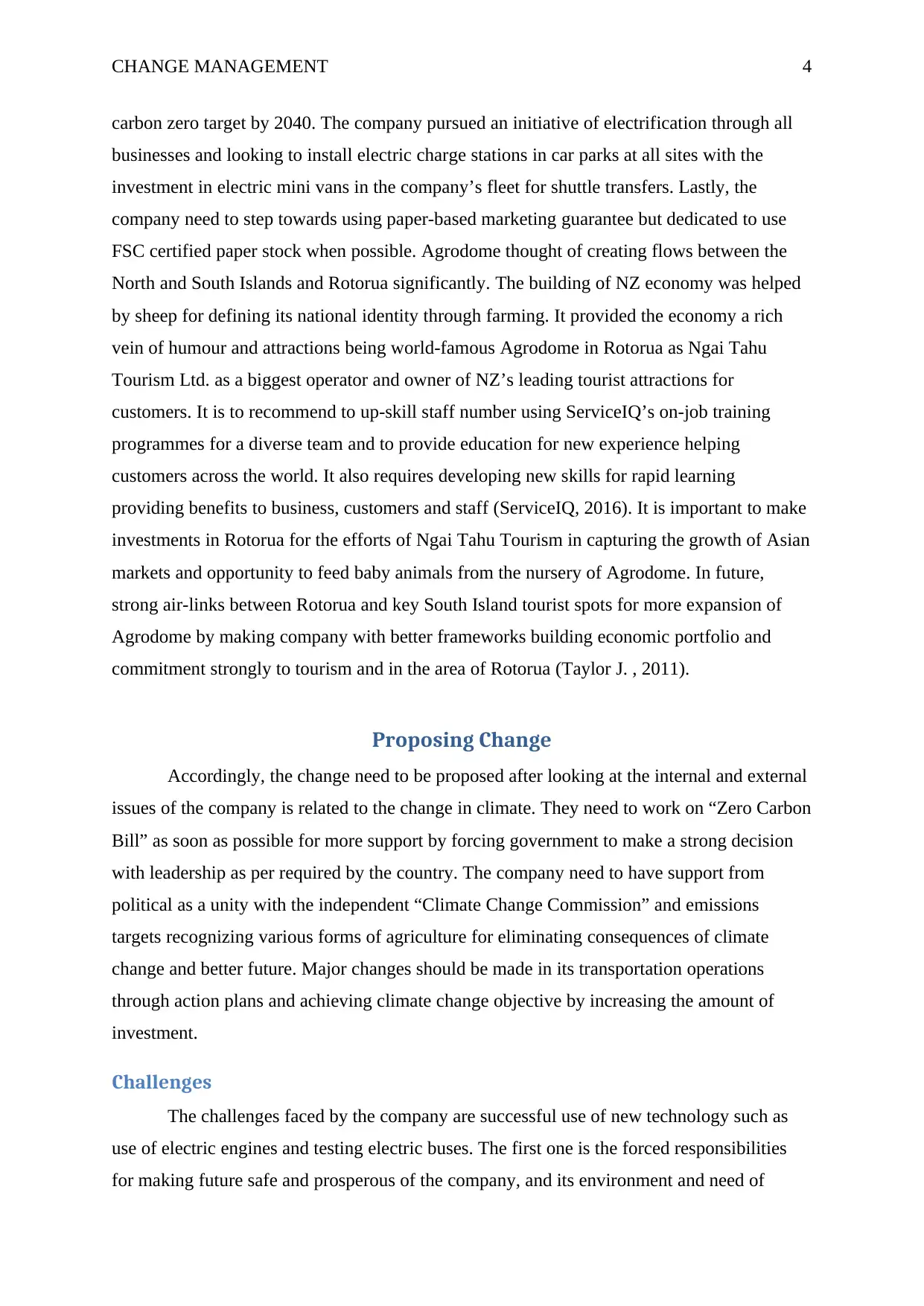
CHANGE MANAGEMENT 4
carbon zero target by 2040. The company pursued an initiative of electrification through all
businesses and looking to install electric charge stations in car parks at all sites with the
investment in electric mini vans in the company’s fleet for shuttle transfers. Lastly, the
company need to step towards using paper-based marketing guarantee but dedicated to use
FSC certified paper stock when possible. Agrodome thought of creating flows between the
North and South Islands and Rotorua significantly. The building of NZ economy was helped
by sheep for defining its national identity through farming. It provided the economy a rich
vein of humour and attractions being world-famous Agrodome in Rotorua as Ngai Tahu
Tourism Ltd. as a biggest operator and owner of NZ’s leading tourist attractions for
customers. It is to recommend to up-skill staff number using ServiceIQ’s on-job training
programmes for a diverse team and to provide education for new experience helping
customers across the world. It also requires developing new skills for rapid learning
providing benefits to business, customers and staff (ServiceIQ, 2016). It is important to make
investments in Rotorua for the efforts of Ngai Tahu Tourism in capturing the growth of Asian
markets and opportunity to feed baby animals from the nursery of Agrodome. In future,
strong air-links between Rotorua and key South Island tourist spots for more expansion of
Agrodome by making company with better frameworks building economic portfolio and
commitment strongly to tourism and in the area of Rotorua (Taylor J. , 2011).
Proposing Change
Accordingly, the change need to be proposed after looking at the internal and external
issues of the company is related to the change in climate. They need to work on “Zero Carbon
Bill” as soon as possible for more support by forcing government to make a strong decision
with leadership as per required by the country. The company need to have support from
political as a unity with the independent “Climate Change Commission” and emissions
targets recognizing various forms of agriculture for eliminating consequences of climate
change and better future. Major changes should be made in its transportation operations
through action plans and achieving climate change objective by increasing the amount of
investment.
Challenges
The challenges faced by the company are successful use of new technology such as
use of electric engines and testing electric buses. The first one is the forced responsibilities
for making future safe and prosperous of the company, and its environment and need of
carbon zero target by 2040. The company pursued an initiative of electrification through all
businesses and looking to install electric charge stations in car parks at all sites with the
investment in electric mini vans in the company’s fleet for shuttle transfers. Lastly, the
company need to step towards using paper-based marketing guarantee but dedicated to use
FSC certified paper stock when possible. Agrodome thought of creating flows between the
North and South Islands and Rotorua significantly. The building of NZ economy was helped
by sheep for defining its national identity through farming. It provided the economy a rich
vein of humour and attractions being world-famous Agrodome in Rotorua as Ngai Tahu
Tourism Ltd. as a biggest operator and owner of NZ’s leading tourist attractions for
customers. It is to recommend to up-skill staff number using ServiceIQ’s on-job training
programmes for a diverse team and to provide education for new experience helping
customers across the world. It also requires developing new skills for rapid learning
providing benefits to business, customers and staff (ServiceIQ, 2016). It is important to make
investments in Rotorua for the efforts of Ngai Tahu Tourism in capturing the growth of Asian
markets and opportunity to feed baby animals from the nursery of Agrodome. In future,
strong air-links between Rotorua and key South Island tourist spots for more expansion of
Agrodome by making company with better frameworks building economic portfolio and
commitment strongly to tourism and in the area of Rotorua (Taylor J. , 2011).
Proposing Change
Accordingly, the change need to be proposed after looking at the internal and external
issues of the company is related to the change in climate. They need to work on “Zero Carbon
Bill” as soon as possible for more support by forcing government to make a strong decision
with leadership as per required by the country. The company need to have support from
political as a unity with the independent “Climate Change Commission” and emissions
targets recognizing various forms of agriculture for eliminating consequences of climate
change and better future. Major changes should be made in its transportation operations
through action plans and achieving climate change objective by increasing the amount of
investment.
Challenges
The challenges faced by the company are successful use of new technology such as
use of electric engines and testing electric buses. The first one is the forced responsibilities
for making future safe and prosperous of the company, and its environment and need of
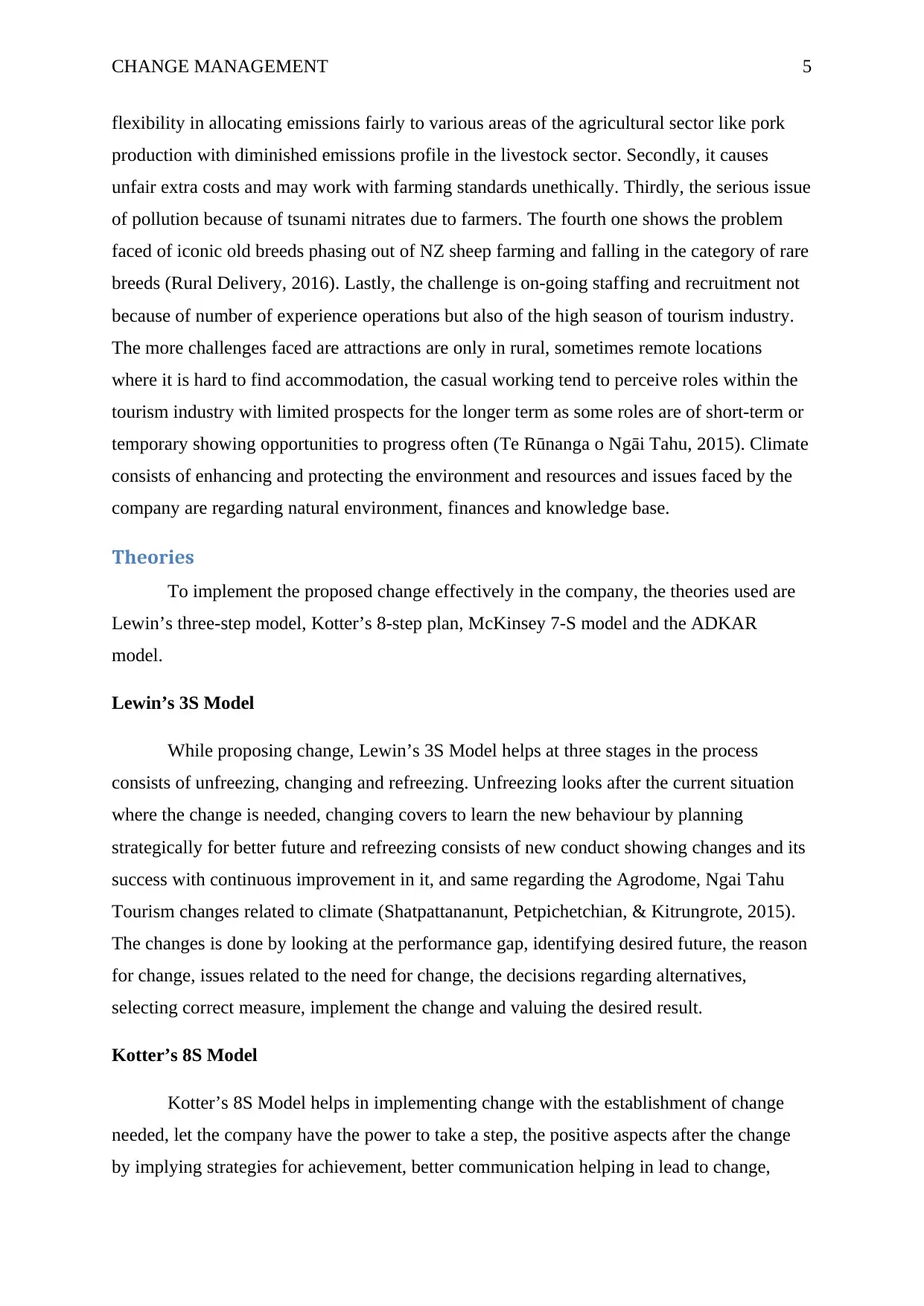
CHANGE MANAGEMENT 5
flexibility in allocating emissions fairly to various areas of the agricultural sector like pork
production with diminished emissions profile in the livestock sector. Secondly, it causes
unfair extra costs and may work with farming standards unethically. Thirdly, the serious issue
of pollution because of tsunami nitrates due to farmers. The fourth one shows the problem
faced of iconic old breeds phasing out of NZ sheep farming and falling in the category of rare
breeds (Rural Delivery, 2016). Lastly, the challenge is on-going staffing and recruitment not
because of number of experience operations but also of the high season of tourism industry.
The more challenges faced are attractions are only in rural, sometimes remote locations
where it is hard to find accommodation, the casual working tend to perceive roles within the
tourism industry with limited prospects for the longer term as some roles are of short-term or
temporary showing opportunities to progress often (Te Rūnanga o Ngāi Tahu, 2015). Climate
consists of enhancing and protecting the environment and resources and issues faced by the
company are regarding natural environment, finances and knowledge base.
Theories
To implement the proposed change effectively in the company, the theories used are
Lewin’s three-step model, Kotter’s 8-step plan, McKinsey 7-S model and the ADKAR
model.
Lewin’s 3S Model
While proposing change, Lewin’s 3S Model helps at three stages in the process
consists of unfreezing, changing and refreezing. Unfreezing looks after the current situation
where the change is needed, changing covers to learn the new behaviour by planning
strategically for better future and refreezing consists of new conduct showing changes and its
success with continuous improvement in it, and same regarding the Agrodome, Ngai Tahu
Tourism changes related to climate (Shatpattananunt, Petpichetchian, & Kitrungrote, 2015).
The changes is done by looking at the performance gap, identifying desired future, the reason
for change, issues related to the need for change, the decisions regarding alternatives,
selecting correct measure, implement the change and valuing the desired result.
Kotter’s 8S Model
Kotter’s 8S Model helps in implementing change with the establishment of change
needed, let the company have the power to take a step, the positive aspects after the change
by implying strategies for achievement, better communication helping in lead to change,
flexibility in allocating emissions fairly to various areas of the agricultural sector like pork
production with diminished emissions profile in the livestock sector. Secondly, it causes
unfair extra costs and may work with farming standards unethically. Thirdly, the serious issue
of pollution because of tsunami nitrates due to farmers. The fourth one shows the problem
faced of iconic old breeds phasing out of NZ sheep farming and falling in the category of rare
breeds (Rural Delivery, 2016). Lastly, the challenge is on-going staffing and recruitment not
because of number of experience operations but also of the high season of tourism industry.
The more challenges faced are attractions are only in rural, sometimes remote locations
where it is hard to find accommodation, the casual working tend to perceive roles within the
tourism industry with limited prospects for the longer term as some roles are of short-term or
temporary showing opportunities to progress often (Te Rūnanga o Ngāi Tahu, 2015). Climate
consists of enhancing and protecting the environment and resources and issues faced by the
company are regarding natural environment, finances and knowledge base.
Theories
To implement the proposed change effectively in the company, the theories used are
Lewin’s three-step model, Kotter’s 8-step plan, McKinsey 7-S model and the ADKAR
model.
Lewin’s 3S Model
While proposing change, Lewin’s 3S Model helps at three stages in the process
consists of unfreezing, changing and refreezing. Unfreezing looks after the current situation
where the change is needed, changing covers to learn the new behaviour by planning
strategically for better future and refreezing consists of new conduct showing changes and its
success with continuous improvement in it, and same regarding the Agrodome, Ngai Tahu
Tourism changes related to climate (Shatpattananunt, Petpichetchian, & Kitrungrote, 2015).
The changes is done by looking at the performance gap, identifying desired future, the reason
for change, issues related to the need for change, the decisions regarding alternatives,
selecting correct measure, implement the change and valuing the desired result.
Kotter’s 8S Model
Kotter’s 8S Model helps in implementing change with the establishment of change
needed, let the company have the power to take a step, the positive aspects after the change
by implying strategies for achievement, better communication helping in lead to change,
⊘ This is a preview!⊘
Do you want full access?
Subscribe today to unlock all pages.

Trusted by 1+ million students worldwide
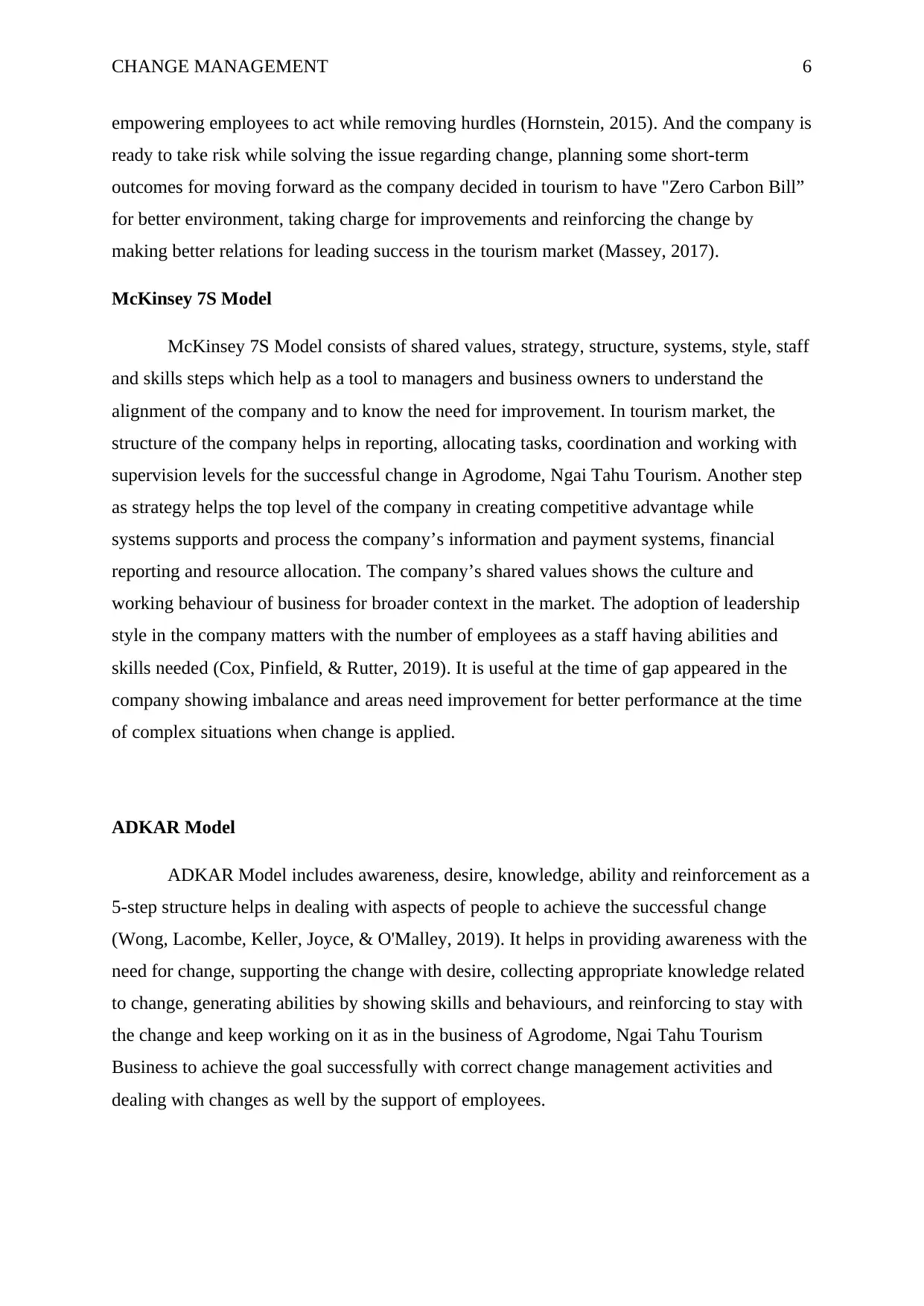
CHANGE MANAGEMENT 6
empowering employees to act while removing hurdles (Hornstein, 2015). And the company is
ready to take risk while solving the issue regarding change, planning some short-term
outcomes for moving forward as the company decided in tourism to have "Zero Carbon Bill”
for better environment, taking charge for improvements and reinforcing the change by
making better relations for leading success in the tourism market (Massey, 2017).
McKinsey 7S Model
McKinsey 7S Model consists of shared values, strategy, structure, systems, style, staff
and skills steps which help as a tool to managers and business owners to understand the
alignment of the company and to know the need for improvement. In tourism market, the
structure of the company helps in reporting, allocating tasks, coordination and working with
supervision levels for the successful change in Agrodome, Ngai Tahu Tourism. Another step
as strategy helps the top level of the company in creating competitive advantage while
systems supports and process the company’s information and payment systems, financial
reporting and resource allocation. The company’s shared values shows the culture and
working behaviour of business for broader context in the market. The adoption of leadership
style in the company matters with the number of employees as a staff having abilities and
skills needed (Cox, Pinfield, & Rutter, 2019). It is useful at the time of gap appeared in the
company showing imbalance and areas need improvement for better performance at the time
of complex situations when change is applied.
ADKAR Model
ADKAR Model includes awareness, desire, knowledge, ability and reinforcement as a
5-step structure helps in dealing with aspects of people to achieve the successful change
(Wong, Lacombe, Keller, Joyce, & O'Malley, 2019). It helps in providing awareness with the
need for change, supporting the change with desire, collecting appropriate knowledge related
to change, generating abilities by showing skills and behaviours, and reinforcing to stay with
the change and keep working on it as in the business of Agrodome, Ngai Tahu Tourism
Business to achieve the goal successfully with correct change management activities and
dealing with changes as well by the support of employees.
empowering employees to act while removing hurdles (Hornstein, 2015). And the company is
ready to take risk while solving the issue regarding change, planning some short-term
outcomes for moving forward as the company decided in tourism to have "Zero Carbon Bill”
for better environment, taking charge for improvements and reinforcing the change by
making better relations for leading success in the tourism market (Massey, 2017).
McKinsey 7S Model
McKinsey 7S Model consists of shared values, strategy, structure, systems, style, staff
and skills steps which help as a tool to managers and business owners to understand the
alignment of the company and to know the need for improvement. In tourism market, the
structure of the company helps in reporting, allocating tasks, coordination and working with
supervision levels for the successful change in Agrodome, Ngai Tahu Tourism. Another step
as strategy helps the top level of the company in creating competitive advantage while
systems supports and process the company’s information and payment systems, financial
reporting and resource allocation. The company’s shared values shows the culture and
working behaviour of business for broader context in the market. The adoption of leadership
style in the company matters with the number of employees as a staff having abilities and
skills needed (Cox, Pinfield, & Rutter, 2019). It is useful at the time of gap appeared in the
company showing imbalance and areas need improvement for better performance at the time
of complex situations when change is applied.
ADKAR Model
ADKAR Model includes awareness, desire, knowledge, ability and reinforcement as a
5-step structure helps in dealing with aspects of people to achieve the successful change
(Wong, Lacombe, Keller, Joyce, & O'Malley, 2019). It helps in providing awareness with the
need for change, supporting the change with desire, collecting appropriate knowledge related
to change, generating abilities by showing skills and behaviours, and reinforcing to stay with
the change and keep working on it as in the business of Agrodome, Ngai Tahu Tourism
Business to achieve the goal successfully with correct change management activities and
dealing with changes as well by the support of employees.
Paraphrase This Document
Need a fresh take? Get an instant paraphrase of this document with our AI Paraphraser
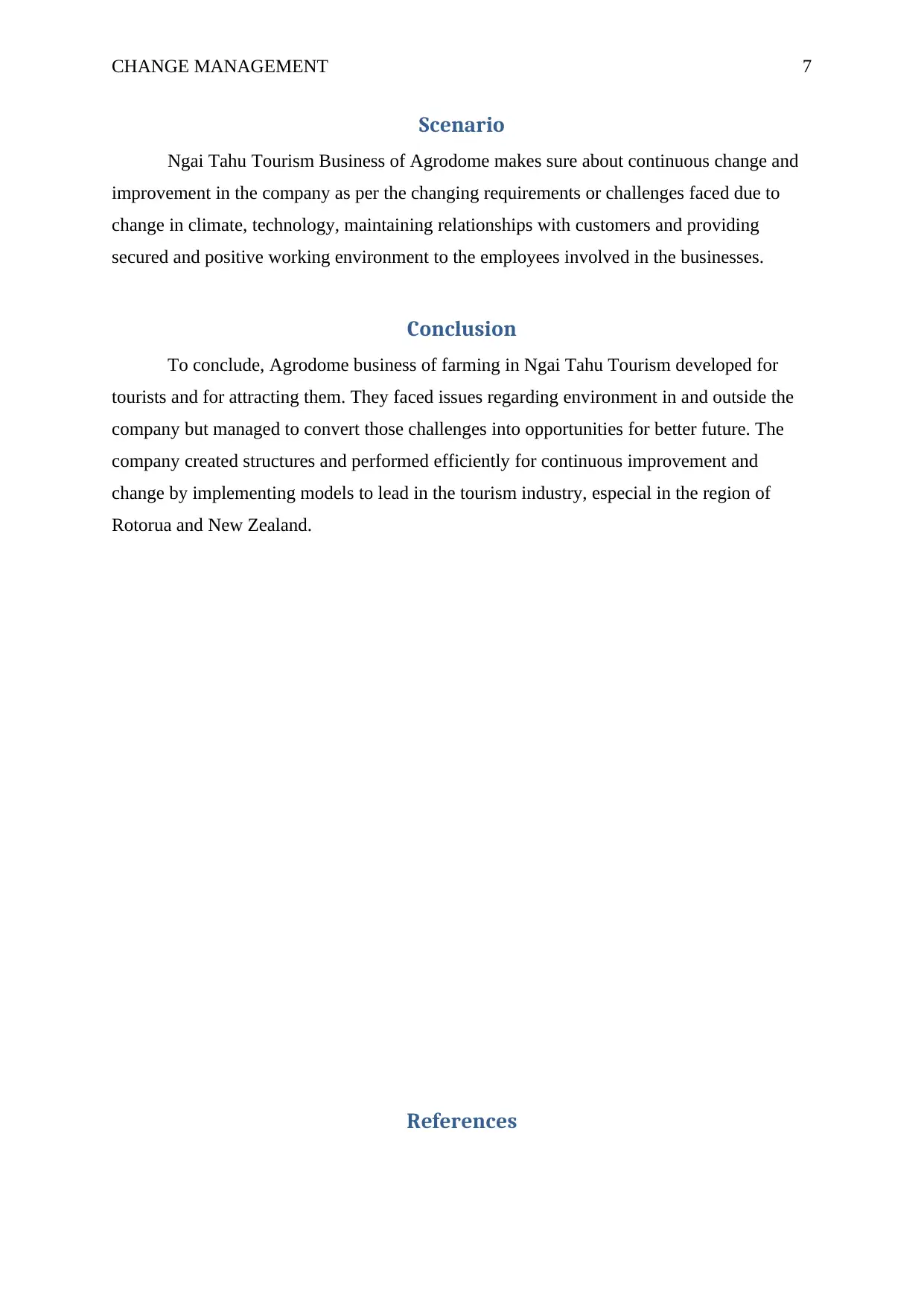
CHANGE MANAGEMENT 7
Scenario
Ngai Tahu Tourism Business of Agrodome makes sure about continuous change and
improvement in the company as per the changing requirements or challenges faced due to
change in climate, technology, maintaining relationships with customers and providing
secured and positive working environment to the employees involved in the businesses.
Conclusion
To conclude, Agrodome business of farming in Ngai Tahu Tourism developed for
tourists and for attracting them. They faced issues regarding environment in and outside the
company but managed to convert those challenges into opportunities for better future. The
company created structures and performed efficiently for continuous improvement and
change by implementing models to lead in the tourism industry, especial in the region of
Rotorua and New Zealand.
References
Scenario
Ngai Tahu Tourism Business of Agrodome makes sure about continuous change and
improvement in the company as per the changing requirements or challenges faced due to
change in climate, technology, maintaining relationships with customers and providing
secured and positive working environment to the employees involved in the businesses.
Conclusion
To conclude, Agrodome business of farming in Ngai Tahu Tourism developed for
tourists and for attracting them. They faced issues regarding environment in and outside the
company but managed to convert those challenges into opportunities for better future. The
company created structures and performed efficiently for continuous improvement and
change by implementing models to lead in the tourism industry, especial in the region of
Rotorua and New Zealand.
References
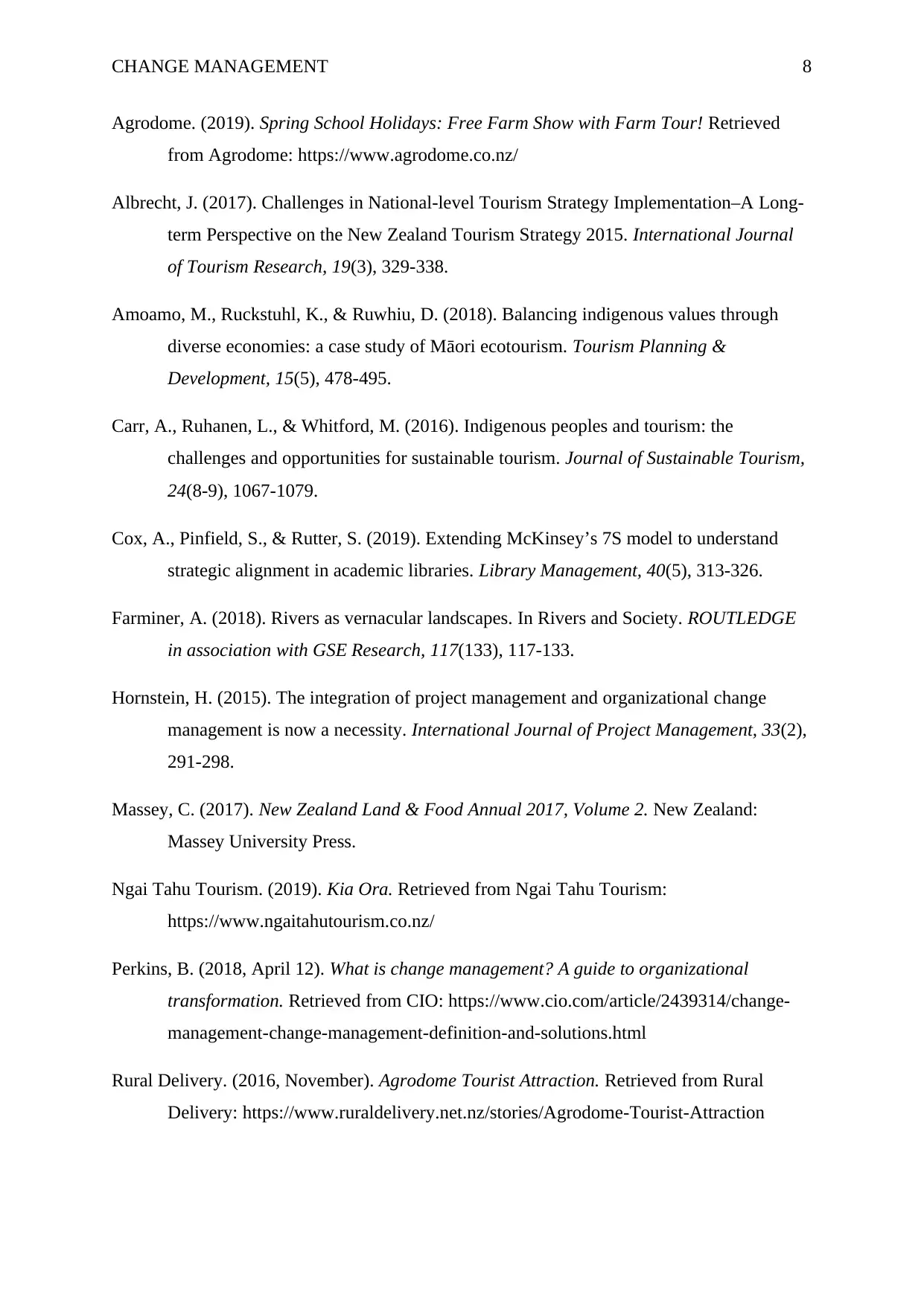
CHANGE MANAGEMENT 8
Agrodome. (2019). Spring School Holidays: Free Farm Show with Farm Tour! Retrieved
from Agrodome: https://www.agrodome.co.nz/
Albrecht, J. (2017). Challenges in National‐level Tourism Strategy Implementation–A Long‐
term Perspective on the New Zealand Tourism Strategy 2015. International Journal
of Tourism Research, 19(3), 329-338.
Amoamo, M., Ruckstuhl, K., & Ruwhiu, D. (2018). Balancing indigenous values through
diverse economies: a case study of Māori ecotourism. Tourism Planning &
Development, 15(5), 478-495.
Carr, A., Ruhanen, L., & Whitford, M. (2016). Indigenous peoples and tourism: the
challenges and opportunities for sustainable tourism. Journal of Sustainable Tourism,
24(8-9), 1067-1079.
Cox, A., Pinfield, S., & Rutter, S. (2019). Extending McKinsey’s 7S model to understand
strategic alignment in academic libraries. Library Management, 40(5), 313-326.
Farminer, A. (2018). Rivers as vernacular landscapes. In Rivers and Society. ROUTLEDGE
in association with GSE Research, 117(133), 117-133.
Hornstein, H. (2015). The integration of project management and organizational change
management is now a necessity. International Journal of Project Management, 33(2),
291-298.
Massey, C. (2017). New Zealand Land & Food Annual 2017, Volume 2. New Zealand:
Massey University Press.
Ngai Tahu Tourism. (2019). Kia Ora. Retrieved from Ngai Tahu Tourism:
https://www.ngaitahutourism.co.nz/
Perkins, B. (2018, April 12). What is change management? A guide to organizational
transformation. Retrieved from CIO: https://www.cio.com/article/2439314/change-
management-change-management-definition-and-solutions.html
Rural Delivery. (2016, November). Agrodome Tourist Attraction. Retrieved from Rural
Delivery: https://www.ruraldelivery.net.nz/stories/Agrodome-Tourist-Attraction
Agrodome. (2019). Spring School Holidays: Free Farm Show with Farm Tour! Retrieved
from Agrodome: https://www.agrodome.co.nz/
Albrecht, J. (2017). Challenges in National‐level Tourism Strategy Implementation–A Long‐
term Perspective on the New Zealand Tourism Strategy 2015. International Journal
of Tourism Research, 19(3), 329-338.
Amoamo, M., Ruckstuhl, K., & Ruwhiu, D. (2018). Balancing indigenous values through
diverse economies: a case study of Māori ecotourism. Tourism Planning &
Development, 15(5), 478-495.
Carr, A., Ruhanen, L., & Whitford, M. (2016). Indigenous peoples and tourism: the
challenges and opportunities for sustainable tourism. Journal of Sustainable Tourism,
24(8-9), 1067-1079.
Cox, A., Pinfield, S., & Rutter, S. (2019). Extending McKinsey’s 7S model to understand
strategic alignment in academic libraries. Library Management, 40(5), 313-326.
Farminer, A. (2018). Rivers as vernacular landscapes. In Rivers and Society. ROUTLEDGE
in association with GSE Research, 117(133), 117-133.
Hornstein, H. (2015). The integration of project management and organizational change
management is now a necessity. International Journal of Project Management, 33(2),
291-298.
Massey, C. (2017). New Zealand Land & Food Annual 2017, Volume 2. New Zealand:
Massey University Press.
Ngai Tahu Tourism. (2019). Kia Ora. Retrieved from Ngai Tahu Tourism:
https://www.ngaitahutourism.co.nz/
Perkins, B. (2018, April 12). What is change management? A guide to organizational
transformation. Retrieved from CIO: https://www.cio.com/article/2439314/change-
management-change-management-definition-and-solutions.html
Rural Delivery. (2016, November). Agrodome Tourist Attraction. Retrieved from Rural
Delivery: https://www.ruraldelivery.net.nz/stories/Agrodome-Tourist-Attraction
⊘ This is a preview!⊘
Do you want full access?
Subscribe today to unlock all pages.

Trusted by 1+ million students worldwide
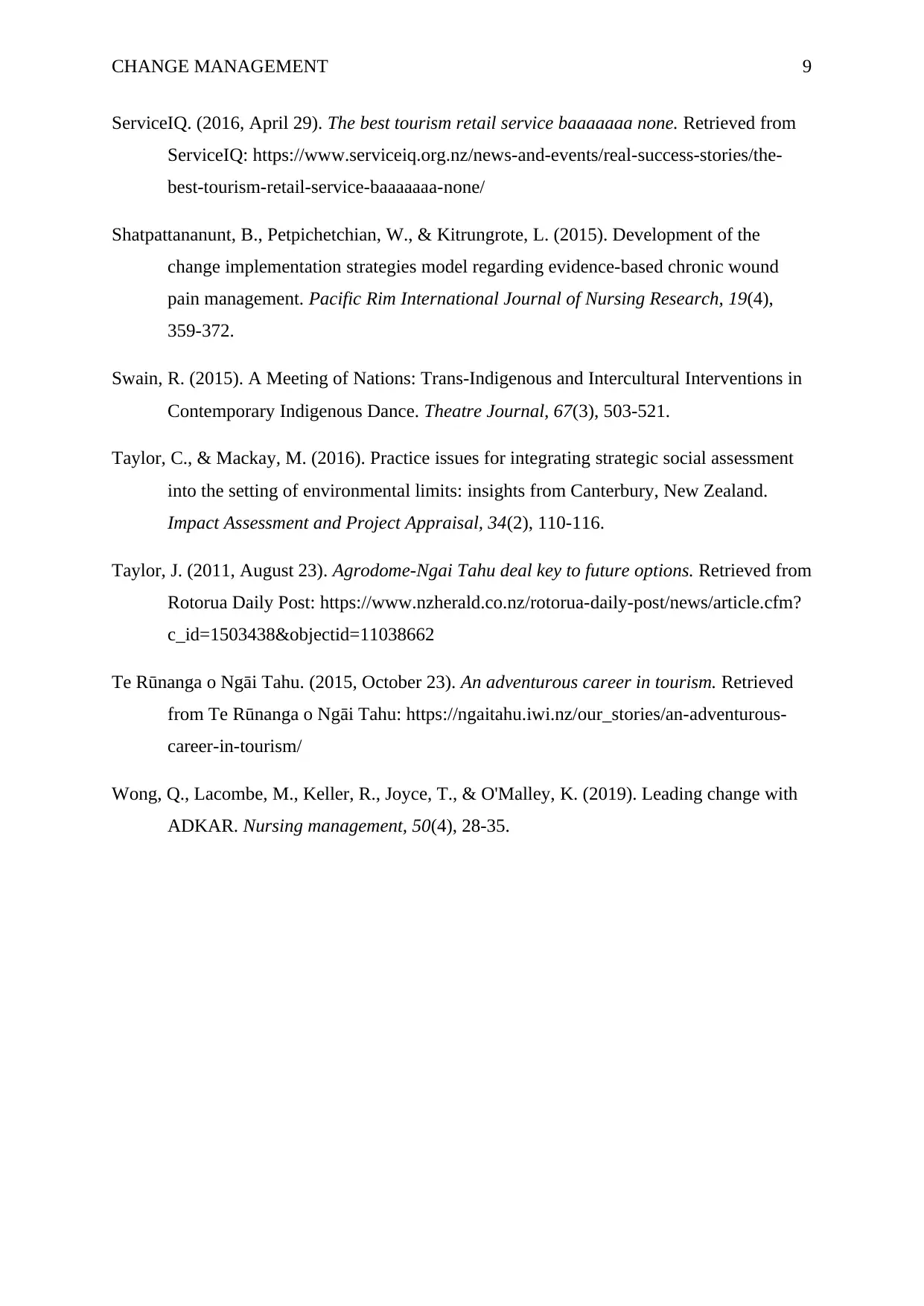
CHANGE MANAGEMENT 9
ServiceIQ. (2016, April 29). The best tourism retail service baaaaaaa none. Retrieved from
ServiceIQ: https://www.serviceiq.org.nz/news-and-events/real-success-stories/the-
best-tourism-retail-service-baaaaaaa-none/
Shatpattananunt, B., Petpichetchian, W., & Kitrungrote, L. (2015). Development of the
change implementation strategies model regarding evidence-based chronic wound
pain management. Pacific Rim International Journal of Nursing Research, 19(4),
359-372.
Swain, R. (2015). A Meeting of Nations: Trans-Indigenous and Intercultural Interventions in
Contemporary Indigenous Dance. Theatre Journal, 67(3), 503-521.
Taylor, C., & Mackay, M. (2016). Practice issues for integrating strategic social assessment
into the setting of environmental limits: insights from Canterbury, New Zealand.
Impact Assessment and Project Appraisal, 34(2), 110-116.
Taylor, J. (2011, August 23). Agrodome-Ngai Tahu deal key to future options. Retrieved from
Rotorua Daily Post: https://www.nzherald.co.nz/rotorua-daily-post/news/article.cfm?
c_id=1503438&objectid=11038662
Te Rūnanga o Ngāi Tahu. (2015, October 23). An adventurous career in tourism. Retrieved
from Te Rūnanga o Ngāi Tahu: https://ngaitahu.iwi.nz/our_stories/an-adventurous-
career-in-tourism/
Wong, Q., Lacombe, M., Keller, R., Joyce, T., & O'Malley, K. (2019). Leading change with
ADKAR. Nursing management, 50(4), 28-35.
ServiceIQ. (2016, April 29). The best tourism retail service baaaaaaa none. Retrieved from
ServiceIQ: https://www.serviceiq.org.nz/news-and-events/real-success-stories/the-
best-tourism-retail-service-baaaaaaa-none/
Shatpattananunt, B., Petpichetchian, W., & Kitrungrote, L. (2015). Development of the
change implementation strategies model regarding evidence-based chronic wound
pain management. Pacific Rim International Journal of Nursing Research, 19(4),
359-372.
Swain, R. (2015). A Meeting of Nations: Trans-Indigenous and Intercultural Interventions in
Contemporary Indigenous Dance. Theatre Journal, 67(3), 503-521.
Taylor, C., & Mackay, M. (2016). Practice issues for integrating strategic social assessment
into the setting of environmental limits: insights from Canterbury, New Zealand.
Impact Assessment and Project Appraisal, 34(2), 110-116.
Taylor, J. (2011, August 23). Agrodome-Ngai Tahu deal key to future options. Retrieved from
Rotorua Daily Post: https://www.nzherald.co.nz/rotorua-daily-post/news/article.cfm?
c_id=1503438&objectid=11038662
Te Rūnanga o Ngāi Tahu. (2015, October 23). An adventurous career in tourism. Retrieved
from Te Rūnanga o Ngāi Tahu: https://ngaitahu.iwi.nz/our_stories/an-adventurous-
career-in-tourism/
Wong, Q., Lacombe, M., Keller, R., Joyce, T., & O'Malley, K. (2019). Leading change with
ADKAR. Nursing management, 50(4), 28-35.
1 out of 10
Your All-in-One AI-Powered Toolkit for Academic Success.
+13062052269
info@desklib.com
Available 24*7 on WhatsApp / Email
![[object Object]](/_next/static/media/star-bottom.7253800d.svg)
Unlock your academic potential
Copyright © 2020–2025 A2Z Services. All Rights Reserved. Developed and managed by ZUCOL.
